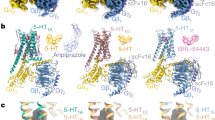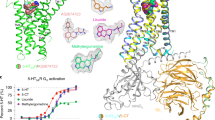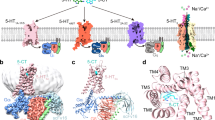Abstract
For more than 40 years the hallucinogen lysergic acid diethylamide (LSD) has been known to modify serotonin neurotransmission. With the advent of molecular and cellular techniques, we are beginning to understand the complexity of LSD's actions at the serotonin 5-HT2 family of receptors. Here, we discuss evidence that signaling of LSD at 5-HT2C receptors differs from the endogenous agonist serotonin. In addition, RNA editing of the 5-HT2C receptor dramatically alters the ability of LSD to stimulate phosphatidylinositol signaling. These findings provide a unique opportunity to understand the mechanism(s) of partial agonism.
Similar content being viewed by others
Main
The serotonin receptor superfamily is composed of 14 members to date which have recently been re-classified based on gene structure, amino acid sequence homology, and intracellular signaling cascades (Hoyer et al. 1994). All but one (5-HT3) of the serotonin receptors couples to G proteins, producing second messengers that regulate cellular functions via phosphorylation/dephosphorylation of intracellular proteins. The five families of G-protein-coupled receptors (5-HT1, 5-HT2, 5-HT4, 5-HT5, and 5-HT7) regulate the two major intracellular second messenger pathways, adenylate cyclase and phospholipase C (for review see Sanders-Bush and Canton 1995) The 5-HT2 receptor family is composed of three subtypes (5-HT2A, 5-HT2B, and 5-HT2C) linked via the Gq/11 family of G proteins to activation of phospholipase C with the generation of two second messengers, IP3 which releases intracellular stores of calcium, and diacylglycerol, which activates protein kinase C. Recently, it has become clear that the 5-HT2 receptor family also has the ability to activate other intracellular signaling pathways. For example, the 5-HT2C receptor has been shown to activate phospholipase A2 (Berg et al. 1996), regulate adenylate cyclase (Lucaites et al. 1996) and increase cyclic GMP (Kaufman et al. 1995). Whether these various signaling pathways are parallel or converging is not yet known, nor is it known what are the relative contribution of these pathways to in vivo function of 5-HT2C receptors in choroid plexus epithelia and neurons.
The ergoline hallucinogenic drug lysergic acid diethylamide (LSD) binds with high affinity to serotonin receptors. Indeed, the early finding that LSD blocks the action of serotonin in smooth muscle (Gaddum 1953; Wooley and Shaw 1954) fueled interest in brain serotonin. Although LSD has been linked to serotonin for more than 40 years, we still cannot explain why LSD has such potent and profound effects on perception, mood, and thought processes. Of the many subtypes of serotonin receptors, the action of LSD at the 5-HT2 family of G-protein-coupled receptors has been most convincingly implicated in the behavioral effects of LSD and other hallucinogenic agents (Titeler et al. 1988). LSD behaves as a partial agonist at 5-HT2A (Burris et al. 1991; Marek and Aghajanian 1996) and 5-HT2C receptors (Sanders-Bush et al. 1988; Egan et al. 1998). Because of its partial agonist proterties, LSD has the potential to partially block the effect of serotonin. It is possible that this 5-HT2A/2C receptor partial agonist property explains the unique behavioral properties of LSD; however, other partial agonists at 5-HT2A/2C receptors, such as m-CPP and lisuride, do not produce LSD-like behavior in humans (Grotewiel et al. 1994; Titeler et al. 1988). Therefore, there must be something unique about LSD versus serotonin that is responsible for its potent hallucinogenic properties (Marek and Aghajanian 1998). This article highlights the differences between LSD and serotonin at the level of receptor signal transduction.
Signaling Properties of the 5-HT2C Receptor when Activated by LSD versus Serotonin
To compare signaling properties of LSD with serotonin, we utilized an NIH 3T3 fibroblast cell line expressing the cloned rat 5-HT2C receptor (3T3/2C cells). In these cells, LSD behaves as a fully efficacious agonist, eliciting a phosphoinositide hydrolysis response that is comparable to serotonin (Figure 1A ) (for methodology, see Barker et al. 1994). Because receptor reserve in phosphoinositide hydrolysis could account for the similar responses, we examined phosphorylation of the 5-HT2C receptor using an immunoblot assay that we developed with our antibodies (Backstrom et al. 1995; Backstrom and Sanders-Bush 1997). In this assay, unglycosylated 5-HT2C receptors have a mass of 40 kDa, and after treatment of 3T3/2C cells with serotonin, an additional band appears with a mass of 41 kDa (Figure 1B). The bandshift could be blocked with antagonists in the presence of serotonin (Backstrom et al., unpublished observation), demonstrating a receptor-mediated event. Extensive studies, including [32P]-incorporation experiments, have unequivocally shown that the 41-kDa band represents a phosphorylated form of the 5-HT2C receptor (Backstrom et al., unpublished observation). At a concentration of 1 μM, LSD was unable to stimulate maximal phosphorylation of the 5-HT2C receptor whereas the hallucinogenic amphetamines DOI and DOB as well as the anxiogenic agonist m-CPP showed equal efficacy relative to serotonin at promoting phosphorylation of the 5-HT2C receptor (Backstrom et al., unpublished observation). To determine if phosphoinositide hydrolysis enhances serotonin-mediated receptor phosphorylation, 3T3/2C cells were pre-treated with the phospholipase C inhibitor U-73122 or the inactive analog U-73343 (Figure 1B). The phospholipase C inhibitor, but not the inactive analog, attenuated serotonin-mediated phosphorylation of the 5-HT2C receptor, demonstrating a critical role for phosphoinositide hydrolysis. We also examined events downstream from phosphoinositide hydrolysis (Figure 2 ) including translocation of immunoreactive protein kinase C to the membrane fraction as an indirect measurement of protein kinase C activation and inositol (1,4,5)-trisphosphate (IP3)-mediated release of intracellular calcium. Both LSD and serotonin promoted translocation of immunoreactive protein kinase C to the membrane fraction, but surprisingly, only serotonin caused detectable calcium release (Backstrom et al., unpublished observation). Furthermore, other partial agonists such as DOI and m-CPP promoted calcium release comparable to serotonin. These observations demonstrate that LSD differentially activates the two arms of the phosphoinositide hydrolysis pathway, as illustrated in Figure 2. Whereas LSD is a fully efficacious agonist at phosphoinositide hydrolysis and translocation of protein kinase C to the membrane, LSD appears to be a partial agonist at calcium release and receptor phosphorylation. If the differential effects of LSD solely reflect its partial agonist properties, then it should promote phosphorylation at the same sites of the 5-HT2C receptor as does serotonin, but with less efficiency. Thus, we are currently determining which amino acids of the 5-HT2C receptor are necessary for agonist-mediated phosphorylation to test the hypothesis that serotonin promotes phosphorylation at sites in addition to those elicited by LSD. These results may provide molecular clues to some 5-HT2C receptor-mediated behavioral effects of LSD that are not observed with DOI (Krebs-Thomson et al. 1998).
5-HT2C receptor-mediated responses measured by phosphoinositide hydrolysis and receptor phosphorylation. (A) Phosphoinositide hydrolysis dose-response curve for serotonin and LSD. NIH 3T3 cells stably expressing the rat unedited (INI) 5-HT2C receptor (3000 fmol/mg protein; 3T3/2C) were labeled overnight with [3H]-inositol. The ability of serotonin to increase [3H]-inositol monophosphate was measured as described previously. LSD is a fully efficacious agonist with respect to phosphoinositide hydrolysis in this cell line. (B) The phospholipase C inhibitor U-73122 (15 μM, lane 1), but not the negative control analog U-73343 (15 μM, lane 2), attenuates serotonin-mediated phosphorylation of the 5-HT2C receptor. The unphosphorylated and phosphorylated forms of the 5-HT2C receptor have masses of 40 and 41 kDa, respectively.
Schematic of 5-HT2C receptor signal transduction and the sites of action of serotonin (5-HT) and lysergic acid diethylamide (LSD). LSD and serotonin are equipotent at promoting phosphoinositide hy-drolysis through phospholipase C (PLC). LSD and serotonin also cause comparable translocation of immunoreactive protein kinase C (PKC) to the membrane Whereas serotonin stimulates mobilization of intracellular calcium, LSD-mediated calcium release was not detected. LSD-mediated phosphorylation of the 5-HT2C receptor was substantially lower than the serotonin signal.
Properties of LSD and Serotonin at 5-HT2C Receptor Isoforms Created by RNA Editing
Our laboratory published the first report showing that the 5-HT2C receptor is subject to post-transcriptional regulation by RNA editing (Burns et al. 1997). RNA editing, defined as an alteration in the coding potential of primary RNA transcripts by mechanisms other than RNA splicing, of a mammalian protein was discovered a decade ago. So far, RNA editing appears to have major functional consequences as illustrated by the profound alterations in the gating properties of the ligand-gated GluRB subunit of AMPA receptors (for review see Simpson and Emeson 1996). The 5-HT2C receptor, the first G-protein-coupled receptor found to be modified by RNA editing, is edited in rat brain at four principal sites yielding 11 RNA isoforms predicting six new 5-HT2C receptors isoforms (Niswender et al. 1998). The RNA isoforms are differentially expressed in brain regions, suggesting different roles for the protein isoforms in these brain regions. Editing at all four positions generates a receptor isoform, referred to as the 5-HT2C-VSV receptor, which has the amino acid sequence in the predicted second intracellular loop of the receptor changed from ile157-asn159-ile161 (5-HT2C-INI) to val157-ser159-val161 (5-HT2C-VSV), as illustrated in Figure 3A . The rat 5-HT2C-VSV receptor isoform has reduced ability to signal through the principal signal transduction pathway, phospholipase C activation (Figure 4 ). Based on indirect evidence, we hypothesized that the 5-HT2C-VSV receptor isoform couples less efficiently to G-proteins and this explains its altered function (Burns et al. 1997).
RNA editing of the rat 5-HT2C receptor decreases the efficiency of activating phosphoinositide hydrolysis. Cell lines expressing either the 5-HT2C-INI receptor (60 fmol/mg protein; 3T3/INI-L) or 5-HT2C-VSV receptor (44 fmol/mg; 3T3/VSV-L) were labeled overnight with [3H]-inositol. The data is expressed as percent of the maximal signal produced by 100 nM serotonin in each cell line. The average EC50 values (n = 3) were 7 ± 0.5 and 273 ± 47 nM for 3T3/INI-L and 3T3/VSV-L, respectively.
We have recently found that the profile of receptor isoforms formed in human (h) brain differs from rat with the generation of a new isoform, h5-HT2C-VGV (Figure 3B) which also has reduced G-protein-coupling efficiency (Niswender et al. 1999). While studying the pharmacological properties of the isoforms expressed in clonal cell lines, we found a fascinating difference for LSD. In cells expressing the nonedited human isoform h5-HT2C-INI (hINI cells), LSD behaved as a partial or nearly full agonist as was found for the rat 5-HT2C-INI isoform, while at the fully edited human isoform h5-HT2C-VGV LSD had markedly attenuated ability to activate the phosphoinositide hydrolysis pathway compared to serotonin (Figure 5 ). If LSD is a partial agonist, then it would have greater efficacy in cells that express a high density of receptors due to the phenomena of receptor reserve. However, the receptor density of cells expressing the h5-HT2C-INI receptor is 5-fold lower than that of cells expressing the h5-HT2C-VGV receptor. Thus, the ability of LSD to elicit phosphoinositide hydrolysis is inversely related to receptor density, a finding that does not support the argument that functional differences between serotonin and LSD reflect partial agonist properties of LSD.
LSD has profoundly lower efficiency to activate phosphoinositide hydrolysis when interacting with the human fully edited isoform, 5-HT2C-VGV receptor. Cells expressing either the human 5-HT2C-INI receptor (250 fmol/mg protein; 3T3/hINI) or human 5-HT2C-VGV receptor (1200 fmol/mg protein; 3T3/hVGV) were labeled overnight with [3H]-inositol. A maximum concentration (1 μM) of serotonin or LSD was added for 15 minutes and the formation of [3H]-inositol monophosphate (IP) was measured. The bars show mean ± standard error for four independent determinations.
PERSPECTIVE
Signaling of LSD at the 5-HT2C receptor differs from that of serotonin. First, although both agonists promote phosphoinositide hydrolysis and translocation of protein kinase C, LSD is unable to promote calcium release. Second, RNA editing of the 5-HT2C receptor creates isoforms with differential sensitivities to LSD- and serotonin-mediated phosphoinositide signaling. If these observations were solely due to partial agonism, then LSD should behave as a partial agonist in other effector pathways. However, Berg et al. (1998) demonstrated that LSD is a more efficacious agonist than serotonin at activation of phopholipase A2 whereas the opposite was found for activation of phospholipase C. Although differential activation of multiple G proteins by the two agonists could account for preferential effector activation (Berg et al. 1998), the addition of our findings of differences within the same pathway raise the possibility that the differences reflect other receptor–protein interactions. Possibilities include proteins that interact with defined protein modules such as the 5-HT2C receptor PDZ binding motif. Because receptor phosphorylation has been shown to play a vital role in receptor–protein interactions (Pawson and Scott 1997; Krupnick and Benovic 1998), we hypothesize that the differences in receptor phosphorylation that we described earlier in this article may be a mechanistic key for explaining the differential actions of LSD and serotonin. Differential interactions between the 5-HT2C receptor and co-activators or signal attentuators may in fact clarify the phenomenon of partial agonism, which after all is merely an operational definition to explain different agonist efficiencies at activating a response.
References
Backstrom JR, Westphal RS, Canton H, Sanders-Bush E . (1995): Identification of rat serotonin 5-HT2C receptors as glycoproteins containing N-Linked oligosaccharides. Mol Brain Res 33: 311–318
Backstrom JR, Sanders-Bush E . (1997): Generation of anti-peptide antibodies against serotonin 5-HT2A and 5-HT2C receptors. J Neurosci Methods 77: 109–117
Barker EL, Westphal RS, Schmidt D, Sanders-Bush E . (1994): Constitutively active 5-hydroxytryptamine2C receptors reveal novel inverse agonist activity of receptor lignads. J Biol Chem 269: 11687–11690
Berg KA, Maayani S, Clarke WP . (1996): 5-hydroxytryptamine2C receptor activation inhibits 5-hydroxytryptamine1B-like function via arachadonic acid metabolism. Mol Pharmacol 50: 1017–1023
Berg KA, Maayani S, Goldfarb J, Scaramellini C, Leff P, Clarke WP . (1998): Effector pathway-dependent relative efficacy at serotonin type 2A and 2C receptors: Evidence for agonist-directed trafficking of receptor stimulus. Mol Pharmacol 54: 94–104
Burns CM, Chu H, Rueter SM, Hutchinson LK, Canton H, Sanders-Bush E, Emeson RB . (1997): Regulation of serotonin-2C receptor G-protein coupling by RNA editing. Nature 387: 303–308
Burris KD, Breeding M, Sanders-Bush E . (1991):(+)Lysergic acid diethylamide, but not its nonhallucinogenic congeners, is a potent serotonin 5-HT1C receptor agonist. J Pharmacol Exp Ther 258: 891–896
Egan CT, Herrick-Davis K, Miller K, Glennon RA, Teitler M . (1998): Agonist activity of LSD and lisuride at cloned 5HT2A and 5HT2C receptors. Psychopharmacology 136: 409–414
Gaddum JH . (1953): Antagonism between lysergic acid diethylamide and 5-hydroxytryptamine. J Physiol (London) 121: 15P
Grotewiel MS, Chu H, Sanders-Bush E . (1994): m-chlorophenylpiperazine and m-trifluoromethylphenylpiperazine are partial agonists at cloned 5-HT2A receptors expressed in fibroblasts. J Pharmacol Exp Ther 271: 1122–1126
Hoyer D, Clarke DE, Fozzard JR, Martin GR, Mylecharane EJ, Saxena PR, Humphrey PP . (1994): International union of pharmacology classification of receptors for 5-hydroxytryptamine (serotonin). Pharmacol Rev 46: 157–203
Kaufman MJ, Hartig PR, Hoffman BJ . (1995): Serotonin 5-HT2C receptor stimulates cyclic GMP formation in choroid plexus. J Neurochem 64: 199–205
Krebs-Thomson K, Paulus MP, Geyer MA . (1998): Effects of hallucinogens on locomoter and investigatory activity and patterns: Influence of 5-HT2A and 5-HT2C receptors. Neuropsychopharmacology 18: 339–351
Krupnick JG, Benovic JL . (1998): The role of receptor kinases and arrestins in G protein-coupled receptor regulation. Annu Rev Pharmacol Toxicol 38: 289–319
Lucaites VL, Nelson DL, Wainscott DB, Baez M . (1996): Receptor subtype and density determine the coupling repertoire of the 5-HT2 receptor subfamily. Life Sci 59: 1081–1095
Marek GJ, Aghajanian GK . (1996): LSD and the phenethylamine hallucinogen DOI are potent agonists at 5-HT2A receptors on interneurones in rat piriform cortex. J Pharmacol Exp Ther 278: 1373–1382
Marek GJ, Aghajanian GK . (1998): Indoleamine and the phenethylamine hallucinogens: Mechanisms of psychotomimetic action. Drug Alcohol Depend 51: 189–198
Niswender CM, Copeland SC, Herrick-Davis K, Emeson RB, Sanders-Bush E . (1999): RNA editing of the human serotonin 5-hydroxytryptamine 2C receptor silences constitutive activity. J Biol Chem 274: 9472–9478
Niswender CM, Sanders-Bush E, Emeson RB . (1998): Identification and characterization of RNA editing events within the serotonin 5-HT2C receptor. NY Acad Sci 861: 38–48
Pawson T, Scott JD . (1997): Signaling through scaffold, anchoring, and adaptor proteins. Science 278: 2075–2080
Sanders-Bush E, Burris KD, Knoth K . (1988): Lysergic acid diethylamide and 2,5-dimethoxy-4-methylamphetamine are partial agonists at serotonin receptors linked to phosphoinositide hydrolysis. J Pharmacol Exp Ther 246: 924–928
Sanders-Bush E, Canton H . (1995): Serotonin receptors: Signal transduction pathways. In Bloom FE, Kupfer DJ (eds), Psychopharmacology: The Fourth Generation of Progress. New York, Raven Press, Ltd., pp 431–441
Simpson L, Emeson RB . (1996): RNA editing. Annu Rev Neurosci 19: 27–52
Titeler M, Lyon RA, Glennon RA . (1988): Radioligand binding evidence implicates the brain 5-HT2 receptor as a site of action for LSD and phenylisopropylamine hallucinogens. Psychopharmacology 94: 213–216
Wooley DL, Shaw E . (1954): A biochemical and pharmacological suggestion about certain mental disorders. Proc Natl Acad Sci 40: 228–231
Acknowledgements
Supported by the National Institutes of Health Research Grants MH34007, DA05181, and NS3589 (ESB); the National Alliance for Research on Schizophrenia and Depression (JB) and the American Epilepsy Society with support from the Lennox Fund (JB); the National Defense Medical Center, Taipei, Taiwan (HC); and the Pharmaceutical Manufacturers Association Foundation, Inc. (CMN).
Author information
Authors and Affiliations
Rights and permissions
About this article
Cite this article
Backstrom, J., Chang, M., Chu, H. et al. Agonist-Directed Signaling of Serotonin 5-HT2C Receptors: Differences Between Serotonin and Lysergic Acid Diethylamide (LSD). Neuropsychopharmacol 21 (Suppl 1), 77–81 (1999). https://doi.org/10.1016/S0893-133X(99)00005-6
Received:
Revised:
Accepted:
Issue Date:
DOI: https://doi.org/10.1016/S0893-133X(99)00005-6








